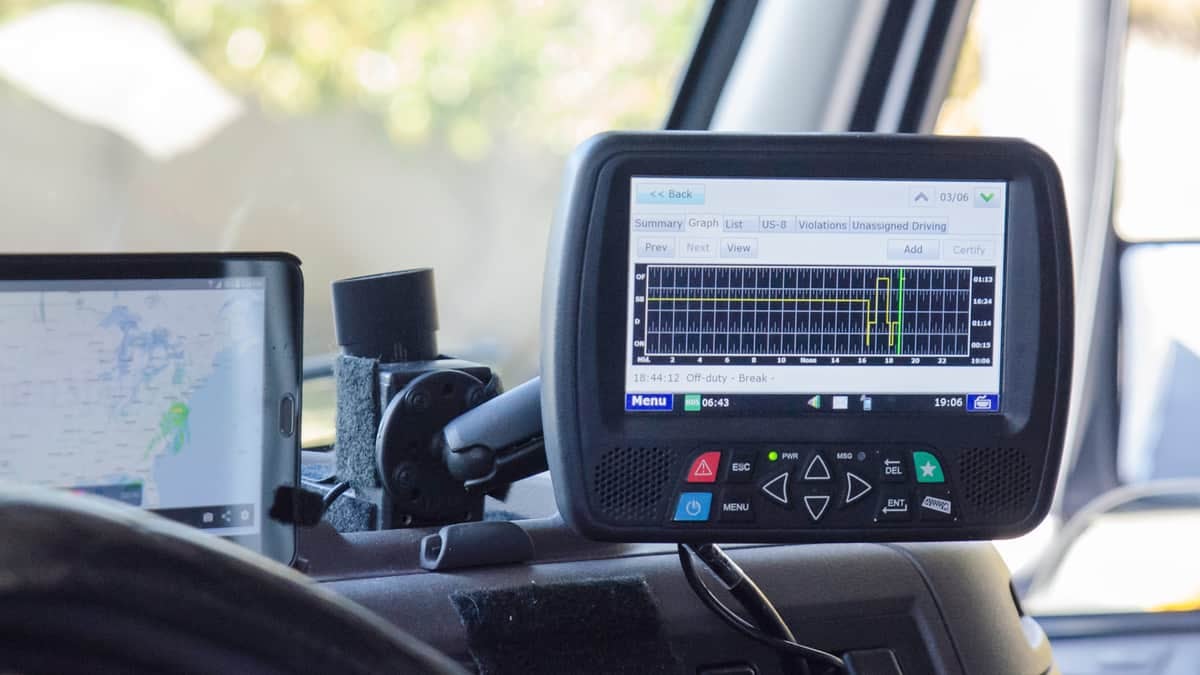The long-awaited proposed changes to federal hours-of-service (HOS) rules for trucking failed to impress most drivers who spoke with FreightWaves, while a group representing independent operators praised increased flexibility that extends the workday.
The Federal Motor Carrier Safety Administration (FMCSA) on Wednesday, August 14, released five proposals intended to ease driving rules for truckers who haul 70 percent of the nation’s freight. The agency will accept public comment for 45 days before finalizing the new rules.
An Advanced Notice of Proposed Rulemaking issued in August 2018 drew more than 5,200 comments. Many criticized a 30-minute rest break required during or immediately after eight hours of driving. Under the proposal, the break could be satisfied by a driver using on-duty, not driving status, rather than off-duty.
“The 30-minute break is a joke. We don’t need it,” said Alex Costerus, a Colorado-based contractor for LandStar System Inc. (NASDAQ: LSTR).
Three-hour pause
The FMCSA also proposed allowing drivers to pause their electronic logging devices (ELD) for up to three hours during a workday. That effectively stretches the 14-hour workday to 17 hours, though the allowable time behind the wheel remains 11 hours in a 14-hour period.

“I think this proposal is another way for carriers to exploit their drivers,” Tim Philmon, a 38-year trucker told FreightWaves. “This is a way for carriers to force their drivers to work fatigued.”
Addressing drowsy driving, a contributor to truck crashes, was a major factor in the FMCSA’s 129-page proposal. Deaths from large truck crashes reached their highest level in 29 years in 2017, according to the National Highway Traffic Safety Administration (NHTSA) data.
The three-hour pause of the ELD would allow an off-duty break without fear of exhausting available driving hours under the 14-hour clock, the FMCSA said.
“There may not be a one-size-fits-all solution, but the proposed changes are positive start since truckers don’t have any control over their schedules or traffic conditions,” said Todd Spencer, president of the Owner-Operator Independent Driver Association (OOIDA). The association petitioned FMCSA for flexibility in the 30-minute break rule and for other changes.
The three-hour break could help avoid traffic congestion, the agency said. The American Transportation Research Institute (ATRI) said in an October 2018 report that traffic bottlenecks and slowdowns cost the industry $74.5 billion in operating losses in 2017.
Fairness vs. flexibility
The fundamental issue is fairness, not flexibility, Costerus said. Most drivers are paid by the mile driven but their hours are governed by an electronic clock.

“With the advent of ELDs, we should be paid by the hour like anybody else,” he said. “All those exemptions to the Fair Labor Standards Act should go away. If that exemption is removed, there would be no driver shortage. The whole level of the profession would go up. Shame on the OOIDA for adding this ‘flexibility.’”
Value of hours worked
Henry Albert is a Texas-based independent driver who urges fewer driving hours, which would make each hour driven worth more.

“As much as everybody hates the 14-hour clock, it’s probably the best thing that ever happened to us because it puts a value on our time,” he said. “Every time your competition stops the clock without charging for it, that makes the issue of time not being valued worse.”
Other modifications
In addition to the rest break modifications, the FMCSA proposed:
- Modifying the sleeper-berth exception to allow drivers to split their required 10 hours off duty into two periods: one period of at least seven consecutive hours in the sleeper berth; and the other period of not less than two consecutive hours, either off duty or in the sleeper berth. Neither would count against the driver’s 14‑hour driving window.
- Extending by two hours the maximum window during which driving is permitted in adverse driving conditions, such as snowstorms.
- Changing the short-haul exception available to certain commercial drivers by lengthening the drivers’ maximum on‑duty period from 12 to 14 hours and extending the distance limit within which the drivers may operate from 100 air miles to 150 air miles.
The FMCSA said the proposed changes would save the U.S. economy and American consumers $274 million.
“Who do you think is going to suffer that revenue loss?” Costerus asked. “This is a further erosion of a driver’s pay and equity.”












Megan
Nice try. I dont like any of these proposal’s. This will fall in the lap’s of the dispatcher’s and will be used in many more ways then one against the driver. The fact that they want to pay drivers by the hour is as funny as seeing a cat with sticky tape on its paws. All a joke! Good luck Drivers & may you enjoy less sleep more work and your pay will stay the same no matter what they come up with. Flipping burgers at Mcdonalds now pays more then you earn and you work twice as many hours! Enjoy!
Kyle
The big issue is waiting at the shipper and receiver. It’s nice to be able to pause the clock for when you are at the shipper and receiver but the wait to get loaded/unloaded is what kills you. Either make them get to you as soon as you arrive, or don’t have the loaded and unloading Times go against the clock. That would help things go a lot better. I’ve seen wait times of 10 hours before and that’s ridiculous. Waiting waste then on duty stats and burns potential driving time, then after waiting, you need to hit the road to make the delivery on time, but you can’t because you burned up the clock waiting to get loaded or unloaded.
Matt
Why hasn’t shipper/receiver abuse of driver hos been addressed? The 17, although great for stopping the eld in traffic, slow driving conditions, etc, it could open drivers up for potential abuse, not only by the aforementioned parties, but by dispatchers, driver managers, etc. I like the idea, but driver abuse protections need to be put in place. Why not just go back to the 16 hour day, keeping the 11 drive, and 34 restart?
What also is needed, in my opinion, is a national carrier wide ban on the freebee wait times at shipper/receivers, or 30 min max, before a high rate detention is assessed. I’ve been at customers where they outright told me, inspite of “appointment times,” they have 2 or 3 hours before detention time. That’s because they’re free! Appointment times mean nothing, unless you’re late. Then, tada!…No detention time in most cases, no matter how long they hold up a driver! Companies should also let customers know, that excessive detention time could also cause the carrier to have the driver just leave. Yeah, wishful thinking. Paid DECENT after 30 would be a good start.
Also, why change the ridiculous, moronic, thoughtless 30 minute rule to an on duty non driving? What genius thought if that? Just get rid of it! It’s useless and insulting! It also causes parking issues, with limited parking as it is!
Driver shortage, lol! Don’t they see the line of trucks on the highway? The jammed truck stops, service plazas, rest areas, and “truck only” parking areas? Not to mention the trucks parked on on/off ramp shoulders, business parking lots, etc! Double or triple the truck parking in the US, then talk adding more trucks! It’s called infrastructure planning! And as mentioned in prior comments, more quality drivers! Not just warm bodies, to fill seats! The whole “driver shortage” cry, we hear every few years, is a sham anyway! A rate lowering scam! More trucks, less freight, more competition, lower rates! The only ones that can absorb that, at least long term, are the large mega companies, that encourage, and survive off of cheap freight rates anyway. The ones hurt are smaller companies, lease and O/Os, and independents. Hmm…agenda? 🤔
16/11/34, 30 min max freebee, no 30 minute break, more parking, and ahh…MORE PARKING!
The hourly rate vs per mile, with the advent of the eld, is a good question/topic too.
Also, enforcement of the no windshield obstruction rule, and footwear rule when driving! I see far too many tasseled curtains on windshields now, and drivers getting out of their trucks, straight from driving, wearing flip flops and sandles. Sorry, but religion or culture should have NO bearing on DOT/FMCSA rules! They should apply to ALL! Enforce them!
pete
you are exactly right!!!